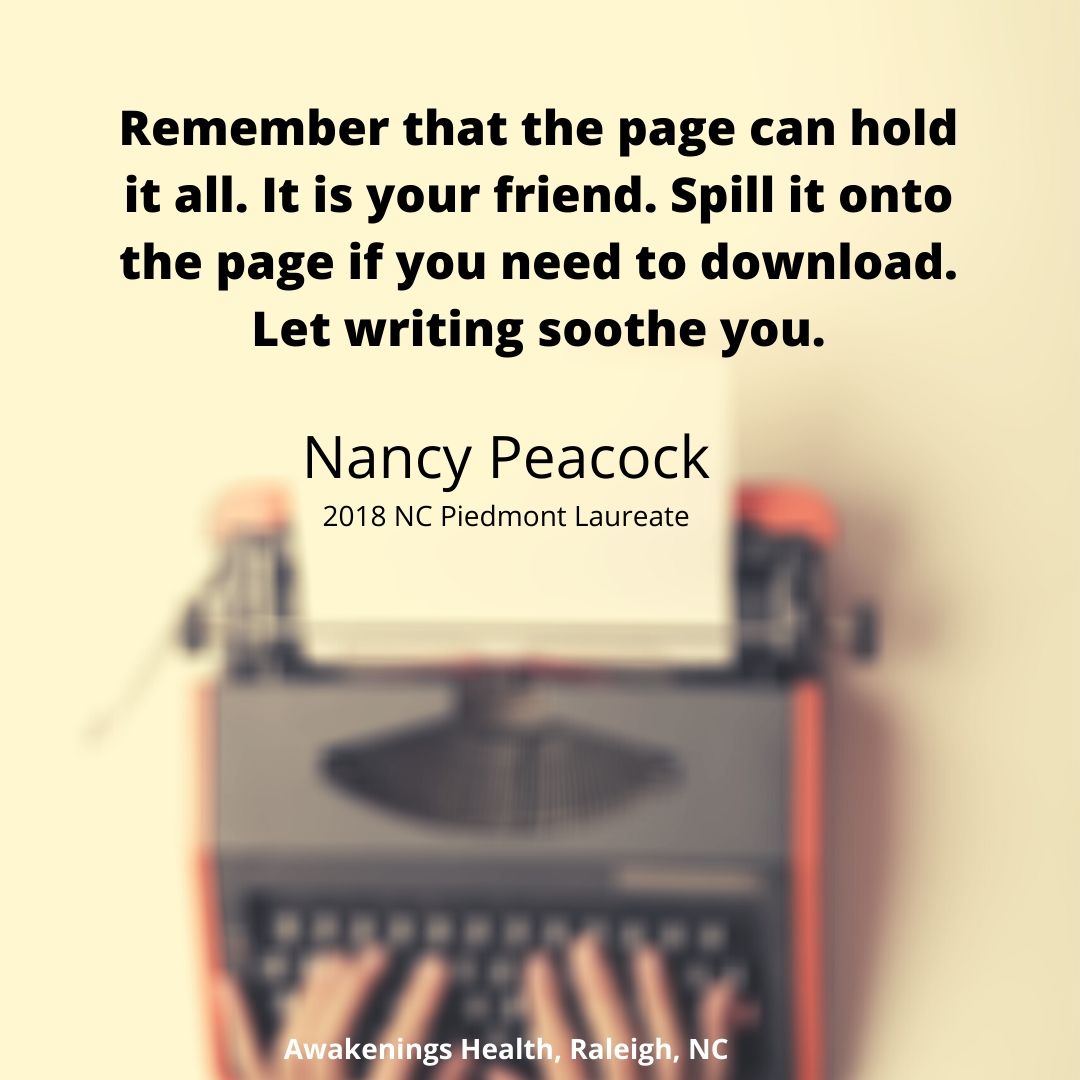Writing for Healing

Writing for Healing
Remember that the page can hold it all. It is your friend. Spill it onto the page if you need to download. Let writing soothe you.
Nancy Peacock, award-winning Hillsborough, NC writer
There’s a tendency to treat human despair as something foreign, an illness that needs to be avoided and/or medicated or controlled or compartmentalized into submission when, ironically, so many of the world’s great souls have taught us that despair and suffering are both universal and deeply kin to our joy.
There is a terrible abundance of background noise in the world right now. We know what the staticky hum comes from: our own fears, social media squabbles, the profoundly concerning news about the virus, all of the things that we’re dealing with as a human family. Even wrestling with the fact that there are some residents of this Beautiful Blue Marble who don’t think we’re a family takes its toll.
It’s important that our anxieties, our despair, our thoughts–the dark and the light of it all–have a place to land. When we deny and fail to give place to our suffering we deny our healing. Writing/therapeutic journaling allows us a place to put our suffering. Though writing is not therapy, writing is a very therapeutic practice.
In the realm of the holistic healing arts we hear a lot about meditation, mindfulness, breathing practices and yoga, but far less often about writing as a restorative practice. That’s unfortunate because writing is accessible to most of us as a form of self-care, demands little time–even 10 minutes of pouring out your insides can pack a powerful de-stressing punch, costs nothing except the price of a notebook and a pen (if you still prefer it old-school like me), doesn’t require a teacher or for us to leave the comfort of the house (or yard or park) and often holds remarkable benefits.
Writing, without thinking about what we’re serving up on the page and without self-editing, puts us in conscious contact with who we are. In a therapeutic writing practice when we allow our deepest feelings and thoughts onto the page, the page becomes a safe place where we do not have to be good (or worse, saintly!), congenial, quick witted, politically correct or well-versed. We can let the soul’s grunge and rubbish fly, knowing that it’s a safe place and knowing that many times the things that we regard as the biggest monsters that lurk in our minds are rarely as scary as they were before we looked them full in the face. Writing is an ideal way to look at our shadows and inner-gremlins of anger, ego and fear full in the face.
Often when we start a journaling practice that involves us leaving all of it on the page, we will be struck with revelations about our needs, our dreams, what we can no longer tolerate and what we long to bring more into focus in our lives. It can also provide a safety valve when you need to release some heat and you don’t want to hurt anyone’s feelings or end up as the next unfortunate hit on YouTube.
What your soul (or mind, or gut or whatever word you’re comfortable with) is telling you is important. The pains and the beauties are all messages, sometimes exquisitely accurate signposts for your journey.
If you would like to start a writing practice (or resume one, maybe you want to wake back up the child in you who once kept a diary), I highly recommend Natalie Goldberg’s “Writing Down the Bones,” Pat Schneider’s “Writing Alone and With Others” and “How the Light Gets In” and Julia Cameron’s “The Artist’s Way” and “Walking in This World.” These books have shaped how so many use writing for personal healing and how I have taught creative and soul-restorative writing in workshops over the last 5 years.
I wrote a piece a few weeks ago that talked about the need to meditate imperfectly for health: (https://tinyurl.com/yagzegbb), please write imperfectly, too. (Let’s just do everything imperfectly as a rule so the old fussy ego knows what to expect!: )) No demands, no pressures about the how; just grab 10 minutes today and see what it feels like to pour off all of the dross from your insides.
Writing tips/techniques:
- Keep a notebook or writing device close at hand. Always! (Who knows? You may have a masterpiece waiting to be born! John Lennon said the key to his success was always having a small pocket-sized notebook at the ready.)
- Start the day with a quick release onto the page. (See Julia Cameron’s “Artist’s Way” for morning pages.)
- End the day with writing. Roses, buds and thorns is one of my favorite writing devices–quickly recount what the roses (blessings), buds (hopes) and thorns (pains) of the day have been. It’s a simple framework but wonderfully powerful!
- Try to write daily, even if it’s just a few minutes here and there.
Alice Walker says that we should create a writing space where we can just be with our words. My fave place is a spot on the living room couch beneath a painting of someone dear to me. Maybe it’s your bedroom, your tub, your car or a park bench.
Article by Deana Vassar of Awakenings Health. If you have any thoughts or questions, please reach out– info@awakeningshealth.com.
